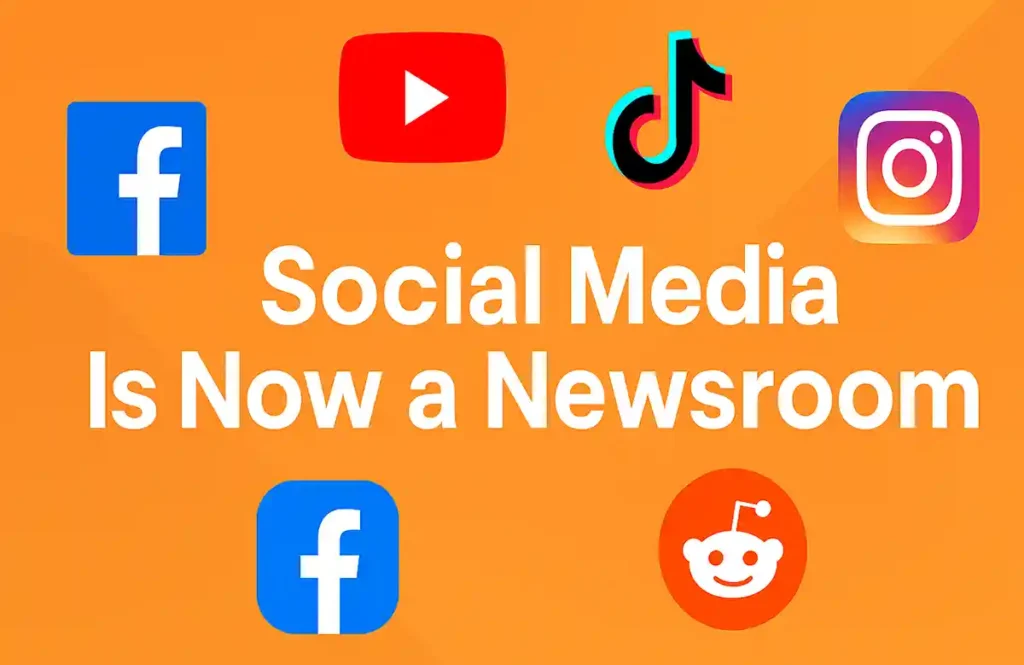New data from the Pew Research Centre reveals that more than half of adults now use social media as part of their news diet. On the surface, this is another incremental update on digital behaviour. But dig deeper, and there are signals here that should make every business owner, SME and marketing agency sit up.
Facebook and YouTube still lead – but TikTok is the disruptor
Facebook remains the leading platform for news consumption, with YouTube close behind. That’s expected. What’s less noticeable, and strategically crucial, is how fast TikTok and Instagram have matured into news channels in their own right.
Just a few years ago, TikTok was considered a form of light entertainment. Now over half its users say they regularly get news there. That shift is massive. It means that “where” people encounter information is changing faster than many brands realise. If your comms plan is still heavily weighted towards Facebook, you’re likely missing tomorrow’s audiences.
Demographics drive platform choice
The Pew research highlights clear generational and behavioural divides. Younger audiences are clustered on TikTok, Instagram and Reddit, while older users remain anchored to Facebook. Men tend to skew more towards YouTube and Reddit, while women are heavier users of Facebook, Instagram, and TikTok.
For agencies and SMEs, this is less about chasing every platform and more about precision targeting. If you sell to younger, experience-driven markets (think hospitality, fashion, lifestyle), TikTok and Instagram aren’t optional anymore. If your core business is financial services or healthcare, Facebook remains your strongest distribution channel.
Niche platforms: low reach, high intensity
Rumble and Reddit might not top the usage charts overall, but they punch above their weight with committed news-hungry audiences. For smaller businesses with tight budgets, these kinds of communities can offer a sharper ROI than trying to fight for visibility on Facebook.
The lesson? Don’t write off niche platforms just because their numbers look small. Look instead at engagement depth versus raw reach.
The algorithm is now the editor
Another hidden implication here: people aren’t “choosing” news outlets in the way they once did. They’re consuming whatever the platform feed serves them. That means algorithms are effectively deciding what gets seen and what doesn’t.
For businesses, that creates both opportunity and risk. On the one hand, great creative or thought leadership can travel quickly. On the other hand, if you’re not optimising for feed visibility or investing in paid social, your content may never surface at all. Social media agencies should be blunt with clients: organic reach is not a strategy.
Credibility becomes the differentiator
With the growth of news consumption on social media, concerns about misinformation are also increasing. This creates a powerful opening for brands that can position themselves as trusted sources of clear, fact-based content. For SMEs, this could mean doubling down on transparency and evidence-backed storytelling. For agencies, it’s a chance to position your service as a filter, helping businesses avoid reputational pitfalls and build trust in environments where credibility is currency. Partnering with the right social media marketing strategy can ensure your content cuts through with authority and consistency.
What this means for your business right now
- Don’t spread yourself too thin: pick 2–3 platforms that align with your audience.
- Factor TikTok and Instagram into any strategy targeting individuals under 40.
- Treat YouTube as more than just a video hosting platform – it’s a discovery engine.
- For smaller budgets, consider niche platforms with loyal user bases.
- Assume algorithms control distribution: optimise and invest accordingly.
- Lead with credibility – misinformation is your competitors’ weakness.
The Strategic Bottom Line
The Pew research shows us that social platforms are no longer just where people chat or scroll; they are where large parts of society go to understand the world. For businesses and agencies, that means marketing is no longer just about visibility; it’s about influence, trust, and timing. The winners will be those who adapt their channel strategy now, before these shifts become yesterday’s news. Independent analysis by Ofcom echoes this trend, showing how social media is reshaping the UK’s own news landscape.


